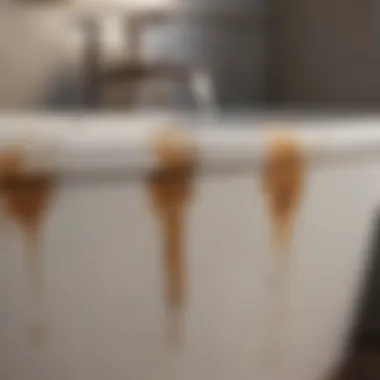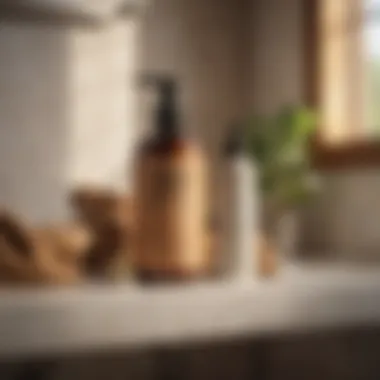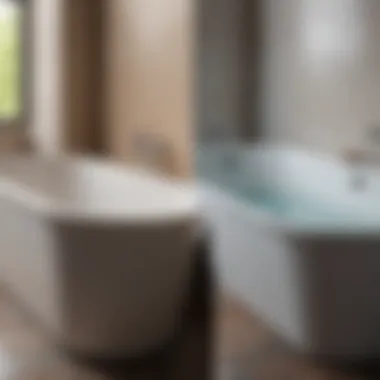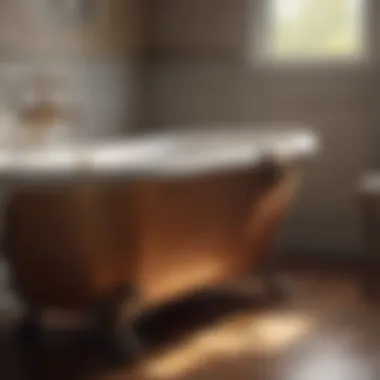Effective Bathtub Rust Cleaners: Tips & Recommendations


Intro
Bathtubs, a central feature in many homes, can sadly fall victim to rust. The process of rust formation usually comes from metal components corroding due to moisture and other environmental factors. It's essential for homeowners and renters alike to understand how rust develops in bathtubs and what methods exist for effective removal. This guide aims to explore not only the causes and implications of rust in bathtubs but also to present effective cleaning solutions available today. Learning about the chemistry behind rust removal provides valuable insights for choosing the right products.
Design Inspirations
Maintaining an attractive bathroom space can enhance overall home aesthetics. While fashionable design may not prevent rust, it can motivate homeowners to keep their bathtubs spotless and well-maintained.
Trending Styles
Bathtubs can reflect various design trends. A popular choice is the freestanding tub, which offers a modern and minimalist look. Encasements made of materials such as acrylic or high-quality ceramics can also play a significant role in design. These choices tend to resist rust better than traditional metal bathtubs. The popularity of vintage styles is also notable, where clawfoot tubs make a bold statement in bathrooms. Selecting a design that matches one's preferences can elevate the bathroom experience, encouraging more care.
Color Palettes
In terms of color, light shades tend to keep bathrooms looking spacious. White is a consistently popular choice due to its timeless appeal. Furthermore, using darker colors may hide stains or rust temporarily, but they may require more maintenance. Soft earth tones can also create a serene atmosphere, reinforcing the importance of cleanliness. Encouraging a positive environment leads to better care and awareness of maintenance needs.
Product Recommendations
Selecting the right products is essential for effective rust removal and prevention. Understanding which tools and cleaning solutions are most suitable can save time and increase efficiency.
Cleaning Supplies
- Baking Soda: A natural abrasive that can lift minor rust stains without damaging surfaces.
- Vinegar: An effective rust remover when combined with baking soda.
- Bar Keepers Friend: A cleaning powder that helps eliminate stubborn rust stains.
- CLR: A well-known chemical solution specifically designed to tackle calcium, lime, and rust.
These products should be applied carefully, following the manufacturer's instructions. Always test on a small area first to ensure compatibility with your bathtub material.
Eco-friendly Solutions
Homeowners increasingly prefer solutions that are kind to the environment. Products containing biodegradable ingredients like lemon juice or hydrogen peroxide can be effective.
- Lemon Juice: The citric acid helps lift rust stains.
- Hydrogen Peroxide: Mixed with baking soda, it can create a powerful rust-removing paste.
Incorporating these solutions not only addresses rust but also reduces chemical runoff into the environment.
Finale
Addressing bathtub rust is essential for maintaining a visually appealing and functional space. Understanding the causes, cleaning methods, and preventative measures can empower homeowners to keep their bathtubs in excellent condition. In addition to practical cleaning solutions, considering design inspirations can contribute to a more enjoyable and engaging bathroom environment. This guide serves as a resource for all those seeking to protect and enhance their bathroom spaces.
Understanding Bathtub Rust
Understanding bathtub rust is crucial for homeowners and renters alike, particularly for those who wish to maintain the longevity and aesthetic appeal of their bathrooms. Rust is not merely an eyesore; it can lead to further structural damage if left untreated. Recognizing how rust forms, its underlying causes, and identifying the specific types of bathtubs vulnerable to rusting are essential for effective management and prevention.
What Causes Rust in Bathtubs?
Rust primarily occurs due to the oxidation of iron and its alloys. This reaction is prompted by moisture, oxygen, and the presence of electrolytes, commonly found in water. In bathtubs, water exposure acts as the primary catalyst. Other contributing factors include:
- Scratches and Chips: Damaging the protective finish of a bathtub exposes raw metal, increasing the likelihood of rust formation.
- High Humidity: Bathrooms with poor ventilation can accumulate moisture that hastens oxidation.
- Poor Water Quality: Water with high mineral content, such as iron or chlorine, can exacerbate rusting.
- Chemical Interactions: Cleaning products or personal care items that contain acids or harsh chemicals can break down protective coatings, thus initiating rust.
Common Types of Bathtubs Prone to Rusting
Certain types of bathtubs are naturally more susceptible to rust. These include:


- Cast Iron Bathtubs: While durable, they are prone to rust if the enamel coating is damaged. The exposed iron reacts with water and air, leading to rust formation.
- Steel Bathtubs: Similar to cast iron, steel bathtubs have a protective coating. However, any wear or tear can expose the metal beneath, resulting in rust.
- Fiberglass and Acrylic: Although these materials do not rust in a traditional sense, they can develop surface stains that may resemble rust if metal fixtures are not maintained properly.
Rust poses a significant threat to the integrity and appearance of bathtubs. Early identification of its causes and understanding which materials are at risk can save homeowners substantial time, effort, and expense in the long run.
The Chemistry Behind Rust Formation
Understanding the chemical processes that contribute to rust formation is crucial for effectively tackling rust issues in bathtubs. The formation of rust is not merely a surface problem; rather, it involves complex reactions that can be influenced by various factors. An awareness of these chemical principles helps in selecting appropriate rust cleaners and can also guide preventive measures to avoid future rust development.
Oxidation Explained
Rust is primarily the result of oxidation, a chemical reaction that occurs when iron or its alloys come into contact with oxygen and moisture. This process transforms the metal into iron oxide, commonly known as rust. The equation for this reaction can be simplified as follows:
[ 4Fe + 3O_2 + 6H_2O \rightarrow 4Fe(OH)_3 \rightarrow 2Fe_2O_3 \cdot 3H_2O ]
Here, iron (Fe) reacts with oxygen (O2) and water (O) to produce hydrated iron oxide. There are a few key points to consider regarding oxidation:
- Environmental Conditions: The rate of oxidation increases dramatically in wet or humid conditions. In bathrooms, where moisture is abundant, this reaction is accelerated.
- pH Levels: Acidic conditions can also expedite oxidation. Harsh cleansers that lower the pH of the water can thus negatively affect the metal, making it more susceptible to rust.
- Preventing Oxidation: Utilizing anti-rust coatings and sealants can effectively minimize exposure to moisture and oxygen, essentially interfering with the oxidation reaction before it begins.
Understanding oxidation is vital as it underlines the need for preventative cleaning practices and the selection of appropriate cleaning products.
The Role of Water Quality
Water quality plays a significant role in rust formation. The minerals and chemicals present in water can either exacerbate or reduce rust potential. It's worth noting the following factors:
- Hard Water: High levels of calcium and magnesium in hard water can lead to deposits that trap moisture against the surface of the bathtub. These deposits contribute to the rust process by creating an ideal environment for oxidation.
- Chlorine and Other Chemicals: Chlorine often used in municipal water systems, can be corrosive to certain metals. This factor can deteriorate the protective layers of the bathtub, making it more vulnerable to rust.
- pH Level of Water: Ideal water for minimizing rust should have a neutral pH. Water that is too acidic can lead to faster oxidation.
Proper water treatment solutions can greatly improve the quality of water and reduce rust formation on bathtubs.
Types of Bathtub Rust Cleaners
Understanding the various types of bathtub rust cleaners is crucial for homeowners aiming to combat rust effectively. This section delineates the two primary categories of rust cleaners: chemical rust removers and natural and eco-friendly solutions. Recognizing the differences and advantages of each type can help you make an informed choice based on your particular needs and values.
Chemical Rust Removers
Chemical rust removers are potent formulations, specifically designed to dissolve rust and restore surfaces. These products often contain ingredients like phosphoric acid or hydrochloric acid. The effectiveness of chemical rust removers is notable, as they can swiftly tackle even stubborn rust stains without excessive scrubbing.
When considering chemical rust removers, a few important factors emerge:
- Speed of Action: They typically act quickly. Many users appreciate seeing results in minutes rather than hours.
- Preparation for Use: While they can be effective, they usually require careful handling. Always wear gloves and eye protection to prevent irritation or injury.
- Surface Compatibility: Check product labels to ensure compatibility with your bathtub material, as some might be too harsh for acrylic or fiberglass.
Natural and Eco-Friendly Solutions
For those who prioritize sustainability, natural and eco-friendly solutions for rust removal present an appealing alternative. These solutions often involve household items like vinegar, baking soda, or lemon juice. While they may not work as rapidly as chemical removers, they offer a safer choice for both users and the environment.
Key points to consider with natural remedies include:
- Ingredient Safety: Many eco-friendly rust cleaners utilize non-toxic substances, reducing health risks associated with harsh chemicals.
- Effectiveness: While these remedies can effectively remove light rust stains, they may struggle with more severe rust damage. Therefore, assessing the severity of rust is important.
- Cost-Effective: Items like baking soda and vinegar are often inexpensive and readily available at home.
In summary, both chemical rust removers and natural solutions possess unique strengths. Selecting the right type for your needs largely depends on your value for speed, safety, and environmental impact.
Evaluating Rust Cleaners: What to Consider


In the quest to eliminate bathtub rust effectively, evaluating rust cleaners is paramount. The right cleaner not only removes the present rust but also safeguards against future occurrences. This section will cover specific elements that should be taken into account.
Effectiveness and Speed of Action
When assessing rust cleaners, their effectiveness is an essential consideration. A reliable rust remover must demonstrate the ability to eradicate rust stains thoroughly. Look for products that specify anti-rust properties and offer evidence of fast action. The quicker the product neutralizes rust, the less number of applications will be required. However, speed should not overshadow effectiveness. A cleaner that works too fast might compromise the quality of the cleaning process.
Safety and Environmental Impact
Safety is another crucial aspect when evaluating rust cleaners. Many commercially available products contain harsh chemicals that may pose health risks. Always check for safety ratings and user reviews regarding irritations or allergic reactions. Furthermore, consider the environmental impact of the cleaner. Eco-friendly options often use natural ingredients, providing a safer choice for both users and the planet. Aim for products with little to no volatile organic compounds (VOCs).
Application Method and Ease of Use
The application method of a rust cleaner significantly influences a user’s experience. Some cleaners require complex processes, while others may offer simple spray-on methods. Choose a cleaner that aligns with personal preferences and cleaning routines. Ease of use ensures that cleaning the bathtub remains a manageable task rather than a daunting chore. Read user instructions carefully and consider if the application method fits well with existing cleaning tools.
"Choosing the right rust cleaner can save time and enhance the overall cleaning experience. Assessing effectiveness, safety, and application ease leads to better results."
Ultimately, thorough evaluation of rust cleaners will empower homeowners to maintain their bathtubs in a pristine condition. By focusing on these criteria, one can choose a rust cleaner that is both efficient and safe.
Recommended Bathtub Rust Cleaners
Understanding effective bathtub rust cleaners is essential for homeowners who aim to keep their bathrooms in top condition. Bathtub rust not only creates a visual nuisance but also can indicate underlying issues related to water quality and material degradation. Selecting the right rust cleaner is crucial for effectively removing stains without damaging the bathtub's surface. Furthermore, many products provide additional benefits, like antibacterial properties or protective layers against future rust development.
With a multitude of options available, it is necessary to consider factors including effectiveness, safety, and ease of use when evaluating rust cleaners. The following subsections will detail the top chemical brands, as well as effective natural remedies that provide viable alternatives for rust removal.
Top Chemical Brands
For those seeking quick and potent solutions, several chemical brands have proven highly effective in the battle against bathtub rust. These products benefit from advanced formulations that target rust stains directly, ensuring effective removal. Brands like CLR and Bar Keepers Friend frequently come up in discussions around the most reputable and efficient rust removers.
- CLR (Calcium Lime Rust Remover): This product is particularly robust against hard water stains and rust. It is a popular choice for its fast-acting capabilities, making it ideal for those who want immediate results. CLR can be used on various surfaces but is essential to follow the instructions closely to avoid damaging sensitive materials.
- Bar Keepers Friend: Known for its versatility, this cleaner excels in removing rust while also polishing surfaces. It is effective on porcelain and acrylic bathtubs. Besides its cleaning properties, it leaves a protective barrier that helps prevent future stains.
Each of these brands provides specific instructions for use. It is vital to pre-test these cleaners in an inconspicuous area to ensure compatibility with your tub’s material.
Effective Natural Remedies
If you prefer to avoid chemical cleaners, there are several natural remedies that can also effectively manage bathtub rust. These solutions often incorporate household items and are appreciated for their eco-friendliness. The following remedies have shown promising results:
- Baking Soda and Vinegar: Mixing these two ingredients creates a potent cleaning solution. Baking soda acts as a mild abrasive, while vinegar dissolves rust. Simply sprinkle baking soda on the affected area, spray with vinegar, and let it sit for several minutes. Then scrub and rinse with warm water.
- Lemon Juice and Salt:
The acidity in lemon juice helps to dissolve rust, while salt provides abrasive action to scrub the stains away. Create a paste, apply it to the rusted areas, and allow it to sit for a few minutes before scrubbing.
These natural cleaners are often gentler on surfaces while still being effective in rust removal. However, they may require more time and effort compared to chemical solutions.
Tip: Regular maintenance can reduce the need for heavy-duty cleaning.
How to Apply Bathtub Rust Cleaner
Cleaning rust from bathtubs is essential for maintaining their appearance and functionality. The application process for rust cleaner can significantly affect the outcome. By knowing the proper techniques and methods, homeowners can achieve effective and lasting results. Understanding the steps to take will also help in avoiding potential damage to the tub surface. This section outlines the preparation, application, and post-cleaning care needed for successful rust removal.
Preparation Steps
Before applying any rust cleaner, preparation is key. This involves several necessary actions to ensure the area is well-managed for cleaning:
- Gather Materials: Collect all necessary materials. This includes the rust cleaner, gloves, sponges or cloths, and possibly a scrub brush.
- Ventilation: Ensure proper ventilation in the area. Open windows or turn on exhaust fans to minimize inhalation of fumes.
- Clear Area: Remove any items from around the bathtub, including shampoo bottles, bath mats, and other products. This not only helps to protect them from harm but also gives you a clear workspace.
- Test Cleaner: If using a new product, conduct a small patch test in an inconspicuous area of the bathtub. This helps to ensure that the cleaner does not damage the surface.
- Read Instructions: Before application, read the manufacturer’s instructions carefully. Each product may have unique requirements to maximize effectiveness and safety.


Step-by-Step Application Process
Once everything is prepared, the following applies to effectively remove rust from your bathtub:
- Apply Cleaner: Follow the manufacturer’s directions for applying the rust cleaner. Usually, it's advised to apply it directly onto the rusted area.
- Let it Sit: Allow the cleaner to sit for the recommended time. This period is critical, as it enables the product to penetrate the rust. Ensure not to leave it for too long, as it might affect the tub’s finish.
- Scrub with Care: Using a sponge or scrub brush, gently scrub the rusted areas. Avoid using metal brushes that can scratch the surface.
- Rinse Thoroughly: After scrubbing, rinse the bathtub with clean water. Make sure to remove all traces of the cleaner. Leftover residue can lead to future staining or damage.
- Dry Surface: Wipe the tub dry with a soft cloth. This step helps prevent water spots or new rust from forming quickly after cleaning.
Post-Cleaning Care
Maintaining the appearance of your bathtub requires a few minor yet effective follow-up steps:
- Inspect for Remaining Rust: After drying, inspect the tub for any remaining rust spots. If any remain, consider applying the cleaner again.
- Keep Dry: Try to keep the tub dry when not in use. Excess moisture can lead to rust returning.
- Regular Maintainence: Schedule routine cleanings to prevent rust buildup. Use gentle cleansers regularly and avoid abrasive materials.
- Apply Sealants: Consider using a protective sealant designed for bathtubs. This can help create a barrier against rust.
Regular maintenance practices will extend the lifespan of your bathtub and keep it looking good.
By following these steps, homeowners can effectively utilize rust cleaners, ensuring their bathtubs remain appealing and functional.
Maintaining a Rust-Free Bathtub
Maintaining a rust-free bathtub involves consistent practices that help homeowners prolong the lifespan and aesthetic appeal of their bathtubs. Rust can be unsightly, and if left unaddressed, it can lead to more severe damage requiring costly repairs. Regular maintenance not only enhances the bath’s appearance but also minimizes the chances of rust formation from the outset. Understanding the methods for keeping bathtubs free from rust will empower homeowners to take effective action and avoid potential pitfalls.
Regular Cleaning Practices
Establishing a routine for cleaning the bathtub is crucial. Regular cleaning can prevent the accumulation of dirt, soap scum, and minerals, which can contribute to rust formation. Here are some recommended practices:
- Use mild cleaners: Acidic or harsh cleaners can damage the tub surface, making it more prone to rust. Mild detergents are a safer choice.
- Soft cloths or sponges: Scrubbing with abrasive materials can scratch the bathtub, creating areas for rust to take hold. Use non-abrasive cloths for cleaning.
- Dry thoroughly after use: Water left standing can lead to rust. Wipe down the tub after showers or baths to keep it dry.
- Schedule regular cleaning: Aim for a cleaning routine that occurs at least once a week to keep rust at bay. Consistency is key here.
"Preventing rust starts with a solid cleaning routine. A few minutes each week can save you hours later on."
Water Treatment Solutions
Water quality significantly impacts rust formation. Hard water contains high levels of minerals like calcium and magnesium, which can encourage rust. Using water treatment solutions can mitigate these effects. Consider these options:
- Water softeners: These systems reduce mineral content in water, making it less likely to cause rust.
- Filtration systems: Installing filters can help remove impurities and sediments that may accelerate corrosion.
- Regular testing: Checking water quality regularly can provide insights into necessary adjustments in treatment methods. Testing kits are available to monitor hardness and pH levels effectively.
Preventive Coatings and Sealers
Applying protective coatings can be beneficial in maintaining bathtub integrity. These products create a barrier that protects against rust and stains. When considering preventive measures, keep these points in mind:
- Choose the right product: Not all coatings are suitable for bathtub surfaces. Look for products specifically formulated for tub use.
- Follow application instructions: Proper application is key to achieving the best results. Ensure surfaces are clean and dry before applying.
- Reapply regularly: Depending on the product, some coatings may need reapplication after certain periods. Regular upkeep will enhance the effectiveness of protective measures.
By implementing these practices, homeowners can effectively maintain a rust-free bathtub. The combination of regular cleaning, proper water treatment, and the use of coatings will not only enhance the bathtub's lifespan but also its overall appearance.
Finale: Effective Rust Management
Managing rust in your bathtub is a vital aspect of home maintenance. Rust not only diminishes the aesthetic appeal of bathrooms but can also indicate underlying issues related to water quality, which may affect other fixtures in your home. By understanding how rust forms, you can better implement cleaning and prevention strategies that preserve the quality and longevity of your bathtub.
Ultimately, effective rust management includes a combination of cleaning, maintenance, and proactive measures. Investing in the right rust cleaner is crucial, but knowing how and when to apply it greatly enhances its effectiveness. Homeowners should recognize the importance of safety in their cleaning choices, particularly with chemical solutions. Moreover, understanding the specific characteristics of their bathtub material can help in choosing solutions that are both effective and non-damaging.
"Regular maintenance is key to preventing rust from becoming a recurring problem."
Key Takeaways for Homeowners
- Understanding Rust: Recognize the causes of rust formation in bathtubs to address issues proactively.
- Product Selection: Choose rust cleaners wisely, considering material compatibility and environmental impact.
- Application Techniques: Employ proper cleaning techniques for maximum effectiveness.
- Regular Maintenance: Establish a routine to regularly clean and inspect the bathtub for rust signs.
- Preventative Measures: Consider water treatment options and sealers to minimize rust risk in the future.
Final Recommendations
- Opt for Quality Cleaners: Select reputable brands like CLR or Bar Keepers Friend for chemical solutions, or consider baking soda and vinegar for a natural alternative.
- Follow Instructions: Adhere strictly to application guidelines provided by manufacturers to ensure safety and efficacy.
- Stay Consistent: Integrate rust management into your regular cleaning schedule to maintain a clean and appealing bathtub.
- Educate Yourself on Materials: Familiarize yourself with the specific material of your bathtub to avoid using abrasive cleaners that may damage its finish.
Applying the above strategies will foster not just a cleaner environment but also enhance the overall lifespan and look of your bathtub.



